Other services: Planetmap | Junocam | Jovian impacts | Venus BepiColombo Flyby
[1]
2025-07-06
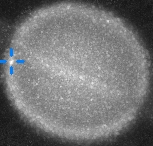 Marc Delcroix reports a potential impact in Saturn captured in a few frames in a video observation obtained by Mario Rana. The potential impact would be very faint and is unconfirmed. The very short impact flash occurred on Saturn on July 5th 2025, between 09:00 and 09:15 UT. It is very important to get other videos of Saturn taken during that time frame.
Marc Delcroix reports a potential impact in Saturn captured in a few frames in a video observation obtained by Mario Rana. The potential impact would be very faint and is unconfirmed. The very short impact flash occurred on Saturn on July 5th 2025, between 09:00 and 09:15 UT. It is very important to get other videos of Saturn taken during that time frame.
Please take the following actions:
- keep your videos taken on 2025.07.05 09h00UT-09:15UT (only original videos could confirm an impact).
- contact Marc Delcroix (delcroix.marc@free.fr) to arrange me getting the video
- you could run DeTeCt on this video, and send me the zip file generated, but again keep your video until getting feedback from me. Please be aware that DeTeCt would not qualify the probability of an impact as high or low as the suspected event is very short.
Please send your feedback to Marc Delcroix (delcroix.marc@free.fr)
2024-11-12
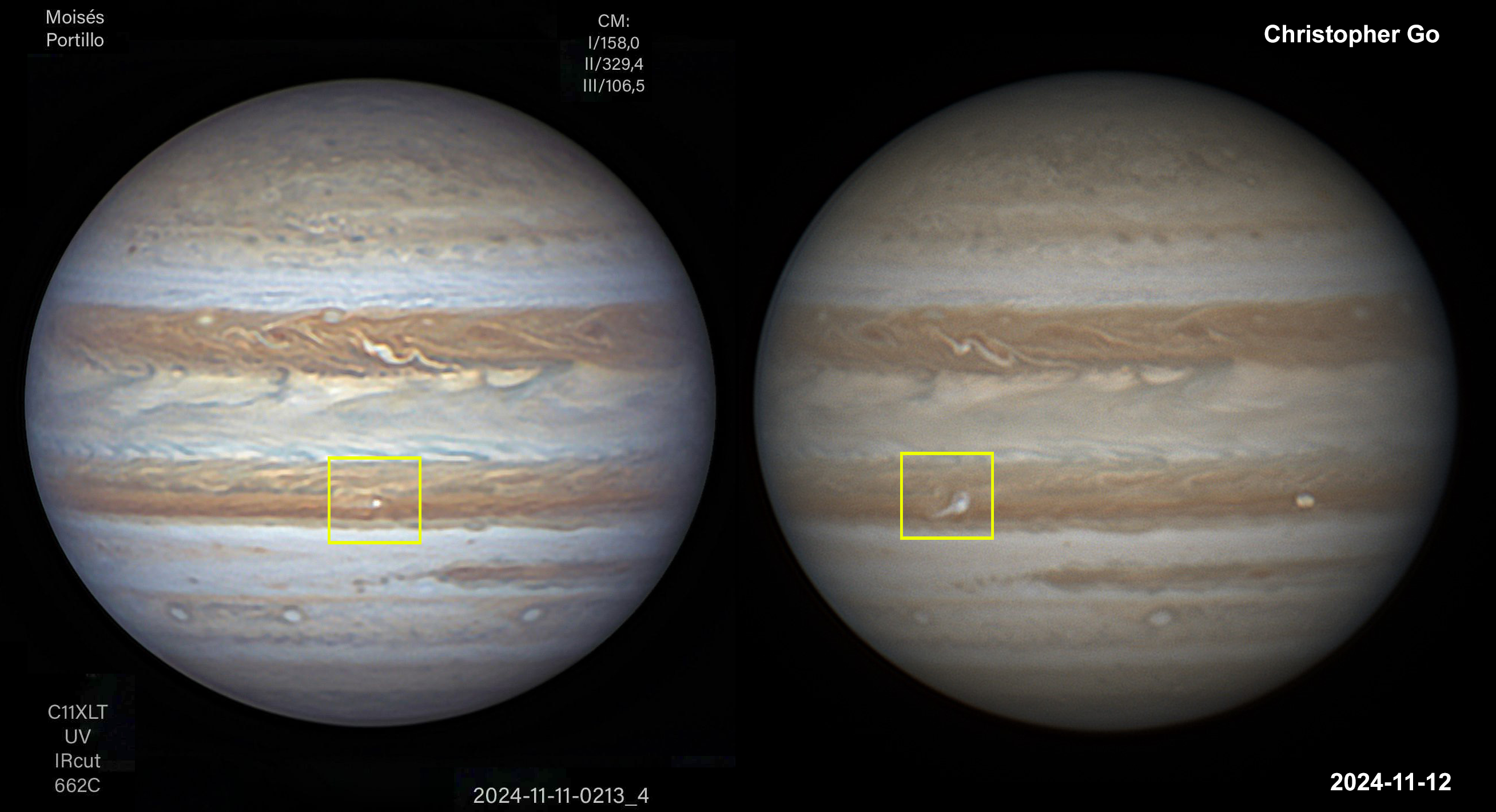
Urgent & Important request for Jupiter images:
Images by Moisés Portillo and Christopher Go show the development of an intense outbreak in the South Equatorial Belt of Jupiter. This is an intense convective storm that started on 11 November and whose activity can develop into a full SEB Disturbance. Observations of the longitude of interest (CMIII=106 deg) over the next 10 days are required to follow the cycle of storm development. Observations in the methane band filter should show a bright convective cloud. Later observations will track the longer-term evolution of the SEB which might experience intense changes in cloud abundance and color over the next months.
As pointed out by Dr. John H. Rogers this activity will become impressive very soon!
Click on the image for a large-scale version of the initial aspect of the SEB
Updated on 18 November: A first report of the SEB outbreak has been prepared by John H. Rogers on the BAA Jupiter Section website and is available at:
https://britastro.org/section_information_/jupiter-section-overview/jupiter-in-2024-25/report-no-2-seb-outbreak-etc
2024-10-04
Mars is coming back in the night sky and Marc Delcroix from the Societé Astronomique de France, together with several collaborators is launching a campaign of observation of Mars with the goal to detect auroras on the planet using blue filter (or stretching the level on the blue channel in colour cameras) to see elevated features on the dark side of the planet compatible with auroras and/or elevated clouds. Given that the sun is close to its maximum activity auroral effects on Mars should be stronger than in previous years.Further information on the following EPSC Abstract presented in September 2024.
Contact Marc Delcroix: delcroix.marc AT free.fr for further details.2024-07-18
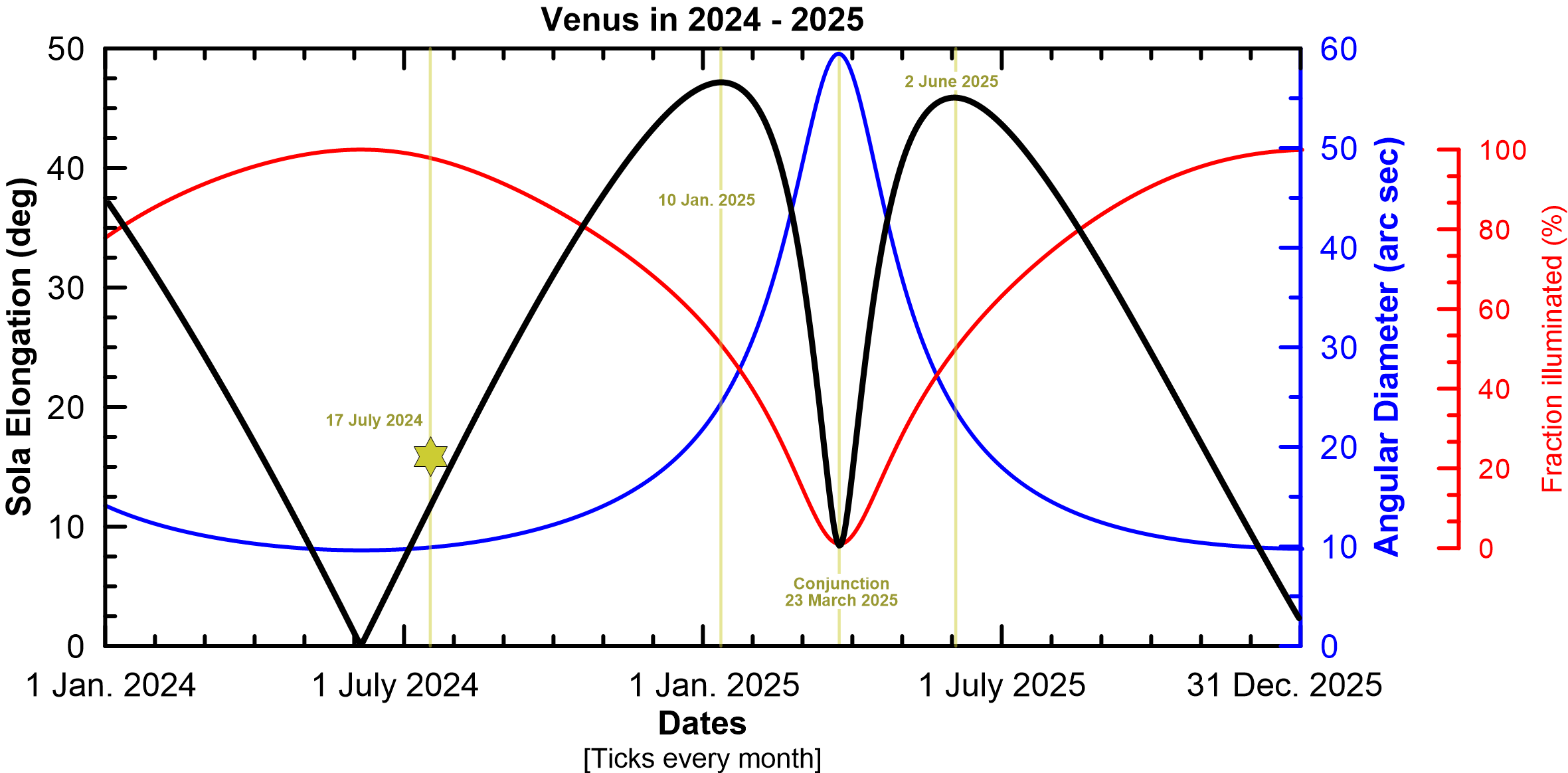
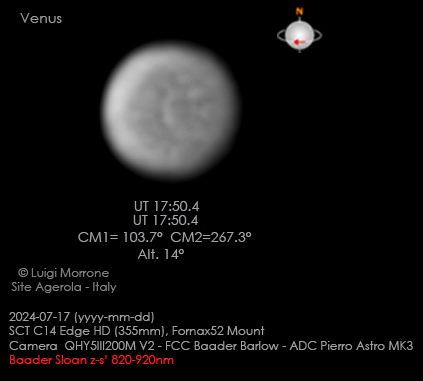 Luigi Morrone from Italy, reports on the presence of the Venus cloud discontinuity in an early observation of Venus in the current Venus apparition. The cloud discontinuity is a recurrent large-scale wave observed to propagate during decades at the deeper clouds of Venus (47–56 km above the surface) and observable on near infrared wavelengths from 700-900 nm. The feature was first identify on Venus observations acquired by the Japanese Akatsuki spacecraft, but it has been the subject of several studies run with amateur observations. The feature circulates around the atmosphere with a period of about 5 days and has been observed once over more than 100 days in succesive rotations of the planets.
Luigi Morrone from Italy, reports on the presence of the Venus cloud discontinuity in an early observation of Venus in the current Venus apparition. The cloud discontinuity is a recurrent large-scale wave observed to propagate during decades at the deeper clouds of Venus (47–56 km above the surface) and observable on near infrared wavelengths from 700-900 nm. The feature was first identify on Venus observations acquired by the Japanese Akatsuki spacecraft, but it has been the subject of several studies run with amateur observations. The feature circulates around the atmosphere with a period of about 5 days and has been observed once over more than 100 days in succesive rotations of the planets.
Observations of the Venus cloud discontinuity in this apparition can constrain the mechanisms that control the onset, evolution and behavior of this large-scale wave. The current apparition discovere on this early stage will allow to replicate and possibly improve over previous studies based on amateur data acquired during the 2019/2020 eastern elongation.
Please report your Venus observations of this cloud discontinuity to Dr. Javier Peralta (email: See the plot on the right for information on Venus observations conditions over 2024-2025. The star marks the date of the early observation by Luigi Morrone.
2024-07-18
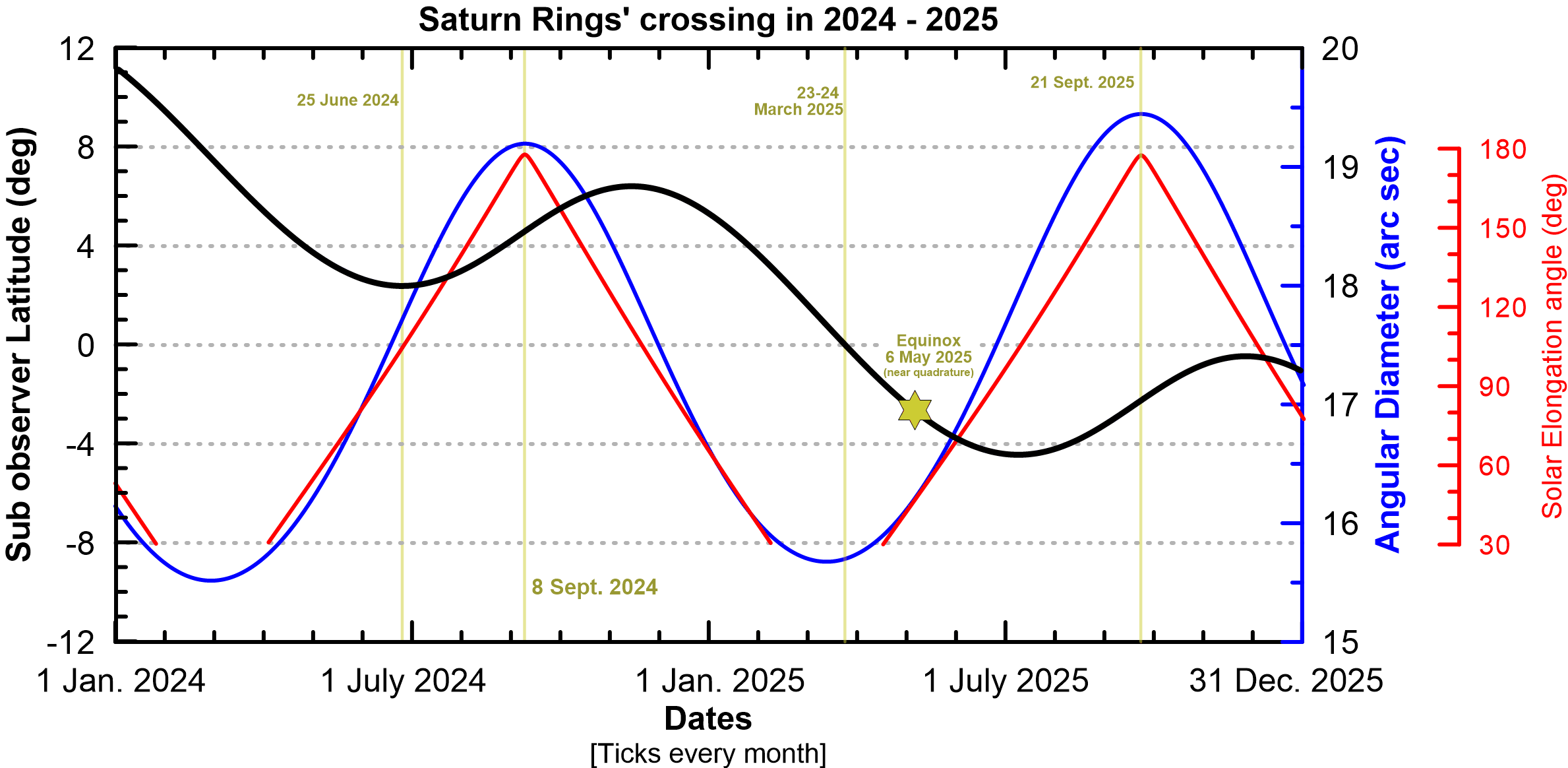
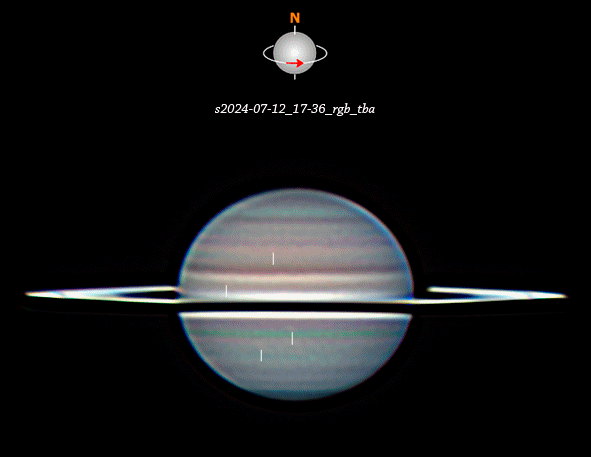 Saturn observations acquired by several amateur observers, notably Trevor Barry, but also many other observers, show a wealth of atmospheric features as the planet approaches Equinox on May 5, 2025, together with changes in the colors of the multiple bands of the planet. Over 2024 and 2025 there are different occasions where the rings appear nearly edge-on from the Earth. Saturn's rings will be exactly edge-on from the Earth on March 23-24, 2025 with the planet at a small solar elongation of only 9.5º. Equinox will occur near quadrature, on May 5, 2025. Observations near Saturn's opposition on Sept. 8, 2024 and Sept. 21, 2025 will provide good opportunities to continue monitoring the changing seasons in Saturn in this key moment in the slow seasonal cycle of Saturn.
Saturn observations acquired by several amateur observers, notably Trevor Barry, but also many other observers, show a wealth of atmospheric features as the planet approaches Equinox on May 5, 2025, together with changes in the colors of the multiple bands of the planet. Over 2024 and 2025 there are different occasions where the rings appear nearly edge-on from the Earth. Saturn's rings will be exactly edge-on from the Earth on March 23-24, 2025 with the planet at a small solar elongation of only 9.5º. Equinox will occur near quadrature, on May 5, 2025. Observations near Saturn's opposition on Sept. 8, 2024 and Sept. 21, 2025 will provide good opportunities to continue monitoring the changing seasons in Saturn in this key moment in the slow seasonal cycle of Saturn.
Observations with the rings edge-on will provide the best possible observations of the bright Equatorial Zone, where time variable winds, and strong vertical wind shears are known to exist in relation with the planet' seasons.
The plot on the right shows the evolution of sub-Earth latitude over Saturn and the key dates of Equinox, opposition together with the changing apparent size of the planet and its elongation from the Sun.
2023-12-29
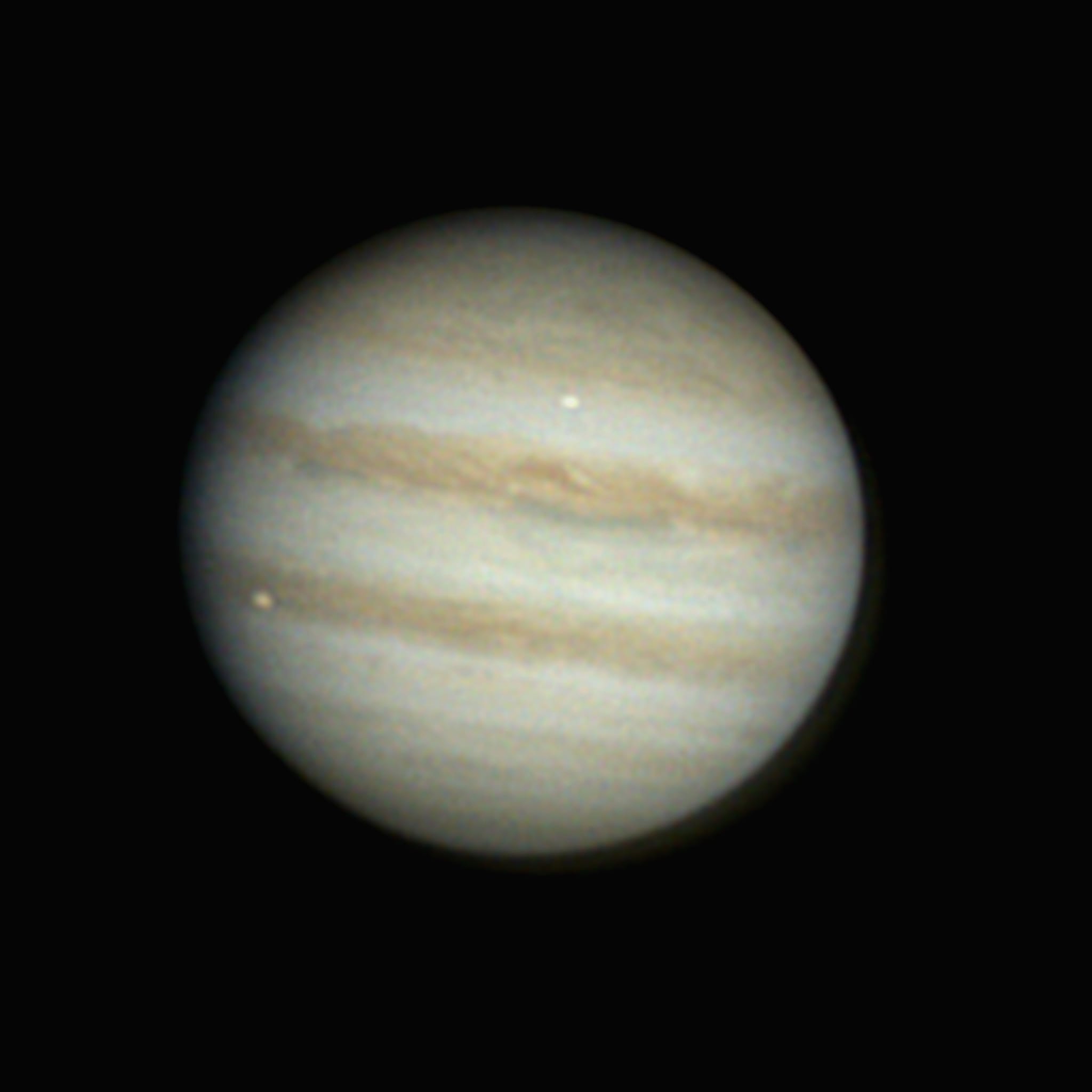
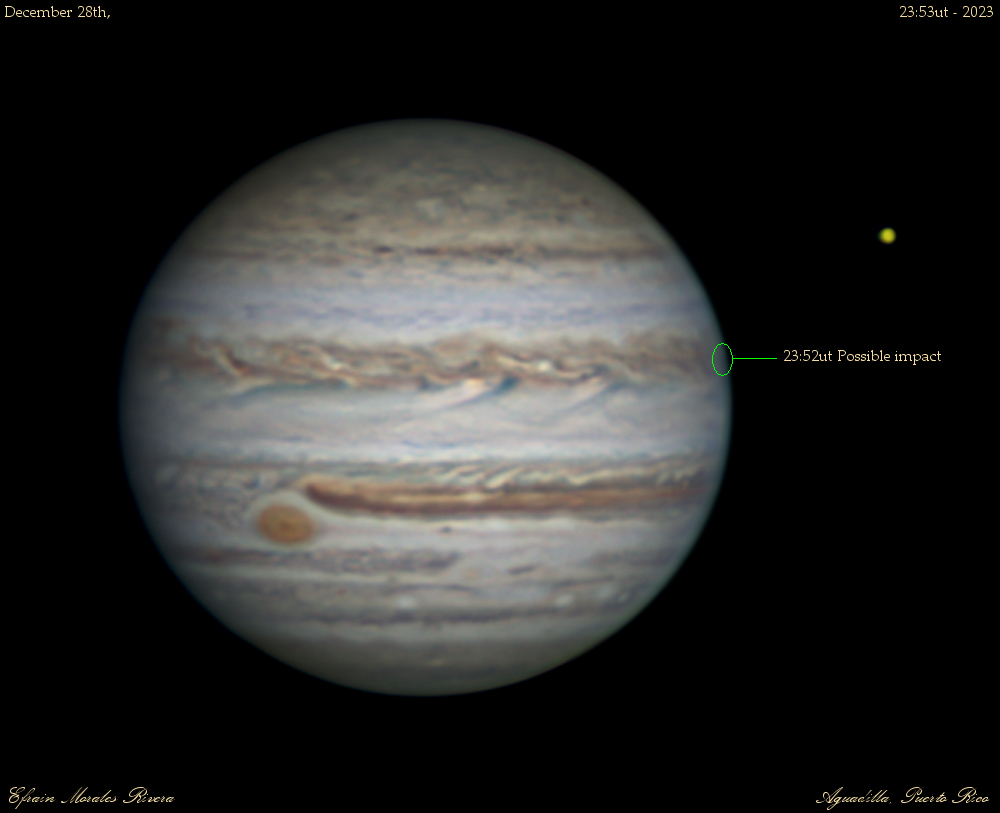 There are two reports of two impacts in Jupiter separated by 24 hr on 28-29 December 2023. If confirmed this could be a series of impacts from a fragmented body colliding with Jupiter over a longer time. Observers interested to follow-up this event should check ALL THEIR VIDEO observations from the last few days and in the next few days to look for potentially new impacts to the two reported below.
There are two reports of two impacts in Jupiter separated by 24 hr on 28-29 December 2023. If confirmed this could be a series of impacts from a fragmented body colliding with Jupiter over a longer time. Observers interested to follow-up this event should check ALL THEIR VIDEO observations from the last few days and in the next few days to look for potentially new impacts to the two reported below.
Impact on December 28, 2023. Status: Not yet confirmed with a video
Efrain Morales, who is an experienced observer from Puerto Rico, spot a bright flash in Jupiter on December 28th around 23:52 UTC. Unfortunately, this was a visual detection on the screen on Efrain's computer, while he was preparing for an image session. The image on the right shows the potential location of the impact. A second report from Brazil with a visual detection too suggests this could be a real impact in Jupiter. If confirmed, this would have been the third impact on Jupiter observed this year. According to Efrain's visual impression of the impact, the bright flash of light on the limb of the planet could have been as bright as a star of magnitude 3 or 4. We encourage all observers who obtained Jupiter videos on December 28th around 23:52 UTC to have a careful look at their video observations of Jupiter.
Observers wishing to obtain images of the impact location and search for a debris field can observe with methane band filters on the 349º-360º(System III) and planetographic latitude 12º.
Impact on December 29, 2023: Status: Video detection
Andrés Arboleda from Colombia observed a second impact on December 29, 2023 at approximate time 23:57-23:58UT. His video observation can be used to extract a light curve and measure the size of the impacting object. Further light curves from other observers are important to better constrain the nature of the impact.
Observers wishing to obtain images of the impact location and search for a debris field can observe with methane band filters on the 221º(System III) and planetographic latitude 30º.
IMPORTANT NOTE ON THESE IMPACTS: The fact that two impacts were reported so closely in time indicates possibilities for further impacts int he next few days. A preliminary image of the impact is shown on the right-most image.
2023-11-16
Japanese observers report a new impact flash in Jupiter. The impact was observed independently by Kunihiko Suzuki, Tsuyoshi Arakawa and Kazuhiro Yamada on 15 November, 2023 at approximate times 12:41:15-12:41:32 UT. The impact was bright and clear with diffraction rings and diffraction spikes. This is the second impact in Jupiter discovered from Japan this year, showing the efficient survey carried by the large number of Japanese amateur observers.You can check ALPO Japan for images by Tsuyoshi Arakawa and X(Twitter) of the different observers to see the videos of the impact.
2023-11-04
With Jupiter at opposition, and many northern hemisphere observers now getting superb high-resolution images, this month is an ideal time for an imaging effort that would, in particular, enable to map the poorly-known flow patterns in the planet’s north polar region (NPR). Some of us made the first detailed study of this region last year [see BAA 2022/23 report no.6], measuring drift rates of some features up to 76°N, and we hope that images this month can yield even better results. Juno’s Perijove-56 is on Nov.22, and JunoCam should be able to get a good map of the planet, including about half the NPR at high resolution. Indeed, this may be JunoCam’s last best opportunity for such a global map, as the instruments will concentrate on very close Io flybys at PJ57 & PJ58, and the views of Jupiter may be less complete thereafter.Therefore, observers who can take hi-res images that resolve details up to the polar regions are asked to do so especially during the period from Saturday Nov.11 to Saturday Dec.3. This is just a request to continue your normal imaging and reporting procedures but perhaps more intensively if you can. A campaign over 3 weeks is desirable to allow sustained tracking of high-latitude features and to allow for gaps due to unfavorable weather. And, of course, your images will also enable detailed study of all other regions of the planet, and will support any observations that professional astronomers may make for PJ56.
PJ56 itself is on Nov.22 with equator crossing at 12:36 (UT at spacecraft) at L3=136. The track will be on the night side, but imaging of it on Nov.22 could be valuable to give context for Juno’s other instruments such as the Microwave Radiometer. Juno’s best sunlit views of the NPR will be on the other side of the planet during its approach.
Clear and steady skies!
John Rogers (BAA)
Shinji Mizumoto (ALPO-Japan)
Glenn Orton (JPL)
Ricardo Hueso (Univ. del Pais Vasco)
Gianluigi Adamoli (JUPOS team)
Rob Bullen (JUPOS team)
Damian Peach (BAA)
2023-09-18
The New Horizons NASA mission has organized ad Uranus/Neptune Observation Campaign with a explicit Request for Groundbased Amateur Observing Support.
NASA’s New Horizons spacecraft plans to observe Uranus and Neptune from its location in the outer solar system in September 2023, concurrently with the Hubble Space Telescope in Earth orbit. The New Horizons science team requests and welcomes observations of both of these ice giant planets from the global amateur astronomy community to enhance the science that the New Horizons and Hubble observations will produce.
Full information about this campaign is available at: Uranus-Neptune-Observations
Images can be uploaded at: https://filerequestpro.com/up/uranus_neptune-campaign
2023-08-29
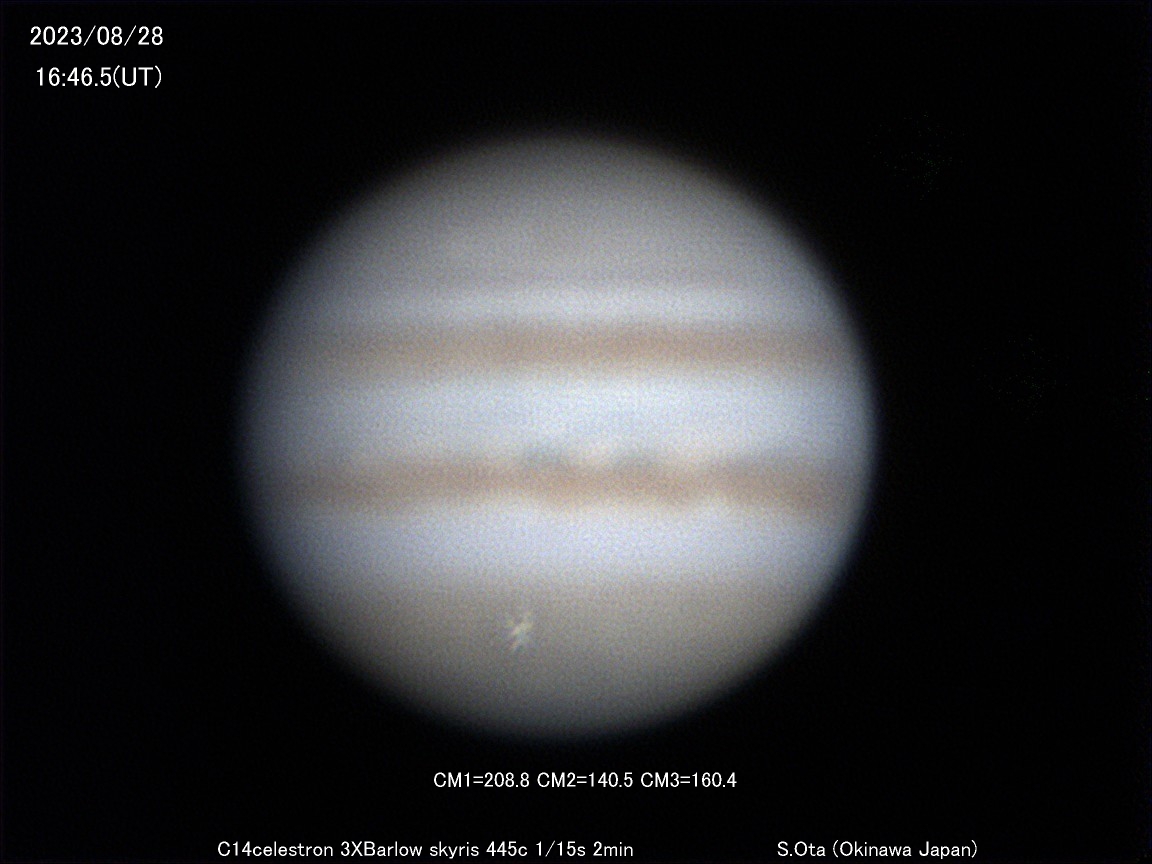 A new flash impact has been discovered in Jupiter's atmosphere. The discoverers of the impact are Tsutomu Ishibashi and Satoshi Ota who used a B390 filter and a color camera respectively. There is a third detection by a visual observer, Mitsuharu Morita visually observing the impact on the monitor between shootings. Later, new reports from different observers have been comunicated through ALPO-Japan and X/Twitter. These include a third video detection by Tadao Ohsugi, using a color camera, Yasuaki Tomita using a monocrome camera, and Masamichi Sekine also using a color camera. In addition, observers from China (Liu Qiqi from Zhengzhou and possibly others) have captured data of the impact with reports on X (Twitter). The image on the right is one of the frames in the video by Satoshi Ota. There are at least 7 independent observations of this impact, which makes this event one of the most widely observed impact flashes on Jupiter's atmosphere.
A new flash impact has been discovered in Jupiter's atmosphere. The discoverers of the impact are Tsutomu Ishibashi and Satoshi Ota who used a B390 filter and a color camera respectively. There is a third detection by a visual observer, Mitsuharu Morita visually observing the impact on the monitor between shootings. Later, new reports from different observers have been comunicated through ALPO-Japan and X/Twitter. These include a third video detection by Tadao Ohsugi, using a color camera, Yasuaki Tomita using a monocrome camera, and Masamichi Sekine also using a color camera. In addition, observers from China (Liu Qiqi from Zhengzhou and possibly others) have captured data of the impact with reports on X (Twitter). The image on the right is one of the frames in the video by Satoshi Ota. There are at least 7 independent observations of this impact, which makes this event one of the most widely observed impact flashes on Jupiter's atmosphere.
Methane-band images by observer Isao Miyazaki about 42 min after the impact do not show any impact scar on the planet confirming a small size of the body similar to previous flash impacts.
More information about the impact is currently available on:
[1]